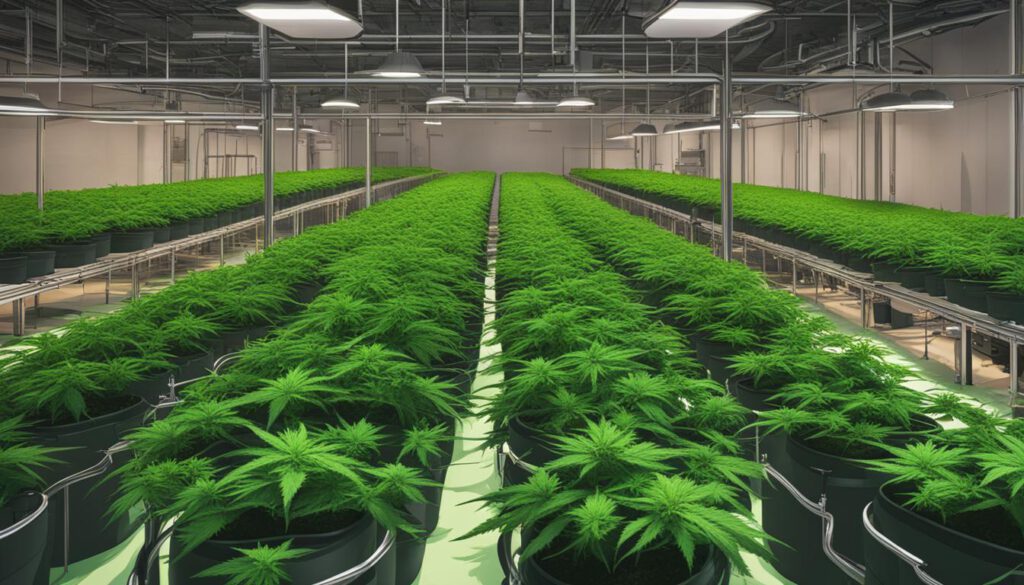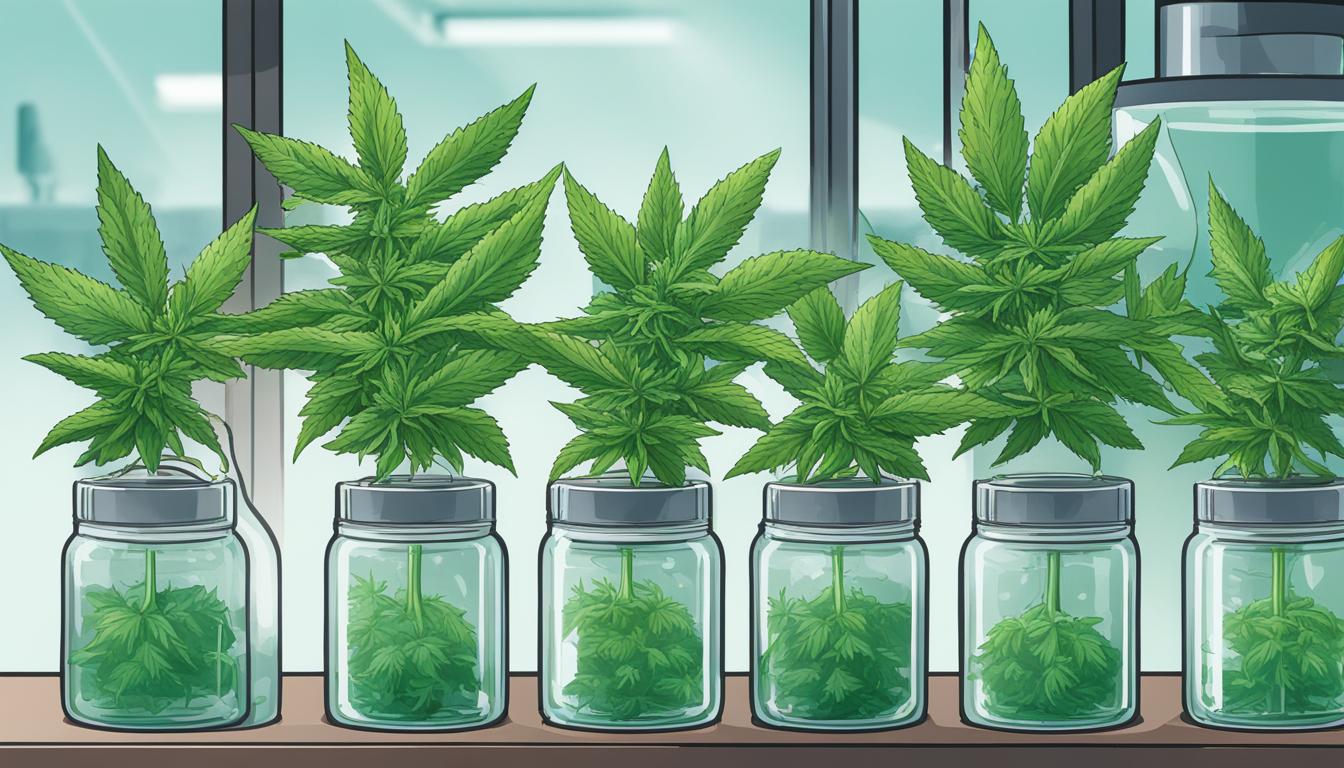If you’re looking to enhance your cannabis cultivation skills, cloning your plants is one of the most effective methods. Cloning is the process of creating a genetically identical copy of a plant, allowing you to grow multiple plants with the exact same characteristics.
While cloning cannabis plants may seem like a daunting task, with the right techniques and tips, it can be a breeze. In this section, we will explore advanced techniques to help you become a cloning expert.
Key Takeaways:
- Cloning is a highly effective way to grow multiple cannabis plants with the same characteristics.
- Advanced techniques can make cannabis plant cloning much easier.
- By following our tips, you can become a cloning expert and significantly enhance your cannabis harvest yield and quality.
Understanding Cannabis Plant Cloning Methods
Cloning cannabis plants can be achieved through different methods. The traditional method involves taking a cutting from a mother plant and planting it in a rooting medium, while more advanced methods involve using specialized equipment and techniques for optimal plant propagation.
Cannabis plant cloning methods can be broadly classified into two categories:
- Vegetative Cutting: This is the traditional method of cloning cannabis plants. A vegetative cutting is taken from a healthy plant and then placed in a rooting medium, which is kept moist until roots form.
- Tissue Culture: This is a more advanced method of cloning cannabis plants. It involves the use of specialized equipment and techniques to create a sterile environment for plant propagation. This method is preferred by expert cultivators because it allows for the production of large quantities of high-quality clones quickly and consistently.
Advanced cannabis plant propagation techniques involve using specialized equipment such as cloning machines or aeroponic systems. Cloning machines allow you to take cuttings and plant them directly in a rooting medium, while aeroponic systems use mist to promote root growth.
Cannabis cloning guide experts recommend experimenting with different methods to find the one that works best for you. It is important to keep in mind that each method has its advantages and disadvantages, and what works for one grower may not work for another.

Pros and Cons of Different Cannabis Plant Cloning Methods
| Method | Pros | Cons |
|---|---|---|
| Vegetative Cutting |
|
|
| Tissue Culture |
|
|
Understanding the pros and cons of different cannabis plant cloning methods can help you choose the most suitable method for your needs. Whether you opt for traditional methods or advanced techniques, remember to follow best practices for successful cloning and optimal plant growth.
Step-by-Step Guide to Cloning Cannabis Plants
If you’re looking to clone cannabis plants, it’s important to understand the step-by-step process to achieve a successful outcome. Follow these guidelines to ensure that your clones thrive.
- Choose the right plant: The first step is to select a healthy mother plant. Choose a plant that has sturdy stems, healthy leaves, and no signs of stress. Look for plants that have produced high-quality buds in the past.
- Prepare cutting tools: Make sure your cutting tools are clean and sharp. You can use scissors or a knife. Clean the tools with rubbing alcohol to prevent the spread of diseases.
- Take cuttings: Cut a healthy branch from the mother plant at a 45-degree angle. The cutting should be around 4-6 inches long and have at least two nodes. Remove the lower leaves, leaving only a few at the top.
- Apply rooting hormone: Dip the cutting into rooting hormone and shake off any excess. This will help the clone develop roots faster.
- Plant the cutting: Place the cutting into a growing medium such as rockwool or soil. Water the cutting and keep it in a warm, humid environment with indirect light. Avoid direct sunlight, which can damage the cutting.
- Monitor progress: Check the cutting regularly for signs of growth. Keep the soil moist but not saturated. Once the cutting has rooted, it can be transplanted into a larger container or the ground.
Following these steps will give you the best chance of success when cloning cannabis plants. Here are some additional best practices to keep in mind:
- Use clean equipment: Always use clean equipment to prevent the spread of disease and improve success rates.
- Avoid overwatering: Overwatering can lead to root rot and other problems. Make sure the soil is moist but not waterlogged.
- Provide proper lighting: Clones need light to grow, but too much direct sunlight can damage the plant. Provide indirect or filtered light for the best results.
- Keep the environment humid: Clones need a humid environment to develop roots. Use a humidity dome or mist the plant regularly to keep the air moist.
Techniques for Growing High-Quality Cloned Cannabis Plants
Cloning cannabis plants is a delicate process that requires a lot of care and attention. However, with advanced cannabis cloning techniques, you can grow high-quality cloned cannabis plants with ease.
Expert Cannabis Cloning Methods
If you want to take your cannabis cultivation skills to the next level, consider using expert cannabis cloning methods. These methods involve advanced techniques, such as tissue culture, that allow you to produce clones that are free from disease and genetic defects.

Optimizing Light and Nutrient Levels
In addition to cloning techniques, optimizing light and nutrient levels is key to growing high-quality cloned cannabis plants. When it comes to lighting, you should use a spectrum that is appropriate for the growth stage of your plants. For nutrients, you should use a balanced formula that provides all the essential elements for vigorous growth.
Avoiding Common Pitfalls
When cloning cannabis plants, there are some common pitfalls you should try to avoid. For instance, you should avoid over-watering your clones, as this can lead to root rot. Additionally, you should avoid using nutrient solutions that are too strong, as this can cause nutrient burn.
Tracking Progress and Adjusting Techniques
Finally, to ensure the best results, it’s important to track your progress and adjust your techniques accordingly. This means keeping track of your plants’ growth and making changes to your cloning techniques as needed. By doing so, you can optimize your cloning methodology and produce high-quality cloned cannabis plants.
Enhancing Harvest Yield and Quality through Cloning
If you’re looking to improve your cannabis harvest yield and quality, cloning is an effective technique to consider. Cloning allows you to replicate your best-performing plants, ensuring that your yield and quality remain consistent. Here are some cannabis plant cloning tips and best practices to help you achieve the best possible results:
Choose the Right Mother Plant
Choosing the right mother plant is essential to the success of your cloning process. Look for a plant that is healthy, disease-free, and has desirable traits such as high yield and potency. It’s also important to choose a mother plant that is not in the flowering stage, as this can reduce the success rate of your clones.
Take Healthy Cuttings
When taking cuttings from your mother plant, make sure they are healthy and free from pests or diseases. Cuttings should be taken from the lower branches of the plant and should be at least four inches long. Make sure to use a clean, sharp tool to make a clean cut, and dip the cuttings into a rooting hormone to promote root growth.
Create the Right Environment
Once you’ve taken your cuttings, it’s essential to create the right environment for them to root and grow. Keep your cuttings in a warm, humid environment with plenty of light. You can use a propagator or a humidity dome to create the ideal conditions for your clones to thrive.
Monitor Your Clones
It’s important to monitor your clones regularly to ensure they are healthy and growing properly. Keep an eye out for signs of stress or disease, and make any necessary adjustments to your environment to promote healthy growth. You should also keep track of the age of your clones and transplant them into larger pots as they grow.
By following these cannabis plant cloning tips and best practices, you can improve the yield and quality of your harvest. Cloning allows you to replicate your best-performing plants, ensuring that your yield and quality remain consistent. Experiment with different techniques and find the approach that works best for you.
Conclusion
Congratulations on completing this article on advanced techniques for cloning cannabis plants. By now, you should have a solid understanding of the different methods and tips to improve your cannabis cultivation skills through cloning.
Remember to always follow best practices for successful cannabis plant cloning, such as maintaining a sterile environment, using high-quality cloning equipment, and providing optimal environmental conditions for your plants.
Experiment and Find Your Approach
It’s essential to experiment with the different techniques mentioned in this article and find the approach that works best for you. Don’t be afraid to try new methodologies, and keep a detailed record of your results. Over time, you’ll be able to refine your cultivation process and produce top-notch yields.
Keep Learning and Growing
Keep in mind that this is just the beginning of your journey towards becoming an expert cannabis cultivator. There’s always more to learn and improve upon, so stay curious and continue to research and educate yourself on new techniques and practices.
Thank you for reading this article, and we hope it has been informative and helpful in enhancing your cannabis cultivation skills.
FAQ
What are some advanced techniques for cloning cannabis plants?
Some advanced techniques for cloning cannabis plants include air layering, tissue culture, and using specialized cloning gels or hormones to promote root growth.
What are the different methods used for cloning cannabis plants?
The different methods used for cloning cannabis plants include traditional cloning, where cuttings are taken from a mother plant, as well as more advanced propagation techniques such as aeroponics and hydroponics.
Can you provide a step-by-step guide to cloning cannabis plants?
Certainly! To clone cannabis plants, you will need to select a healthy mother plant, take cuttings, dip them in a rooting hormone, plant them in a suitable cloning medium, provide adequate light and humidity, and monitor their progress until they develop roots and can be transplanted.
How can I grow high-quality cloned cannabis plants?
To grow high-quality cloned cannabis plants, it is important to maintain proper environmental conditions such as temperature and humidity, provide adequate nutrition through a balanced nutrient solution, and ensure proper pest and disease management.
How can cloning enhance the yield and quality of my cannabis harvest?
Cloning can enhance the yield and quality of your cannabis harvest by allowing you to reproduce genetically superior plants with desirable traits. Cloned plants also tend to have a more uniform growth pattern, leading to more consistent results.
What are some tips for successful cannabis plant cloning?
Some tips for successful cannabis plant cloning include using clean and sharp cutting tools, selecting healthy mother plants, keeping a sterile working environment, providing proper lighting and humidity, and monitoring the clones closely for signs of rooting and growth.











